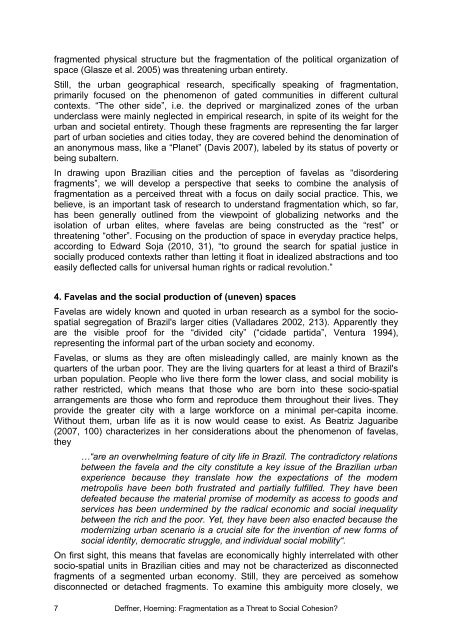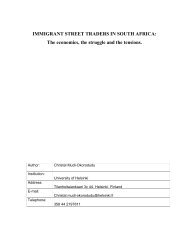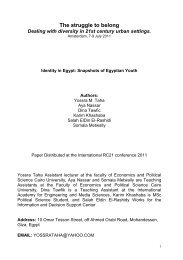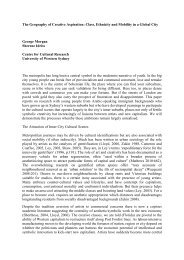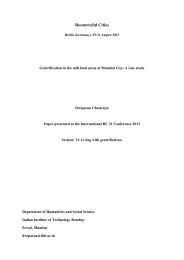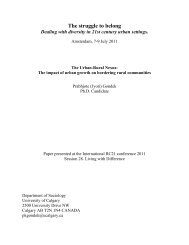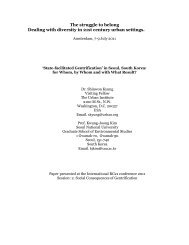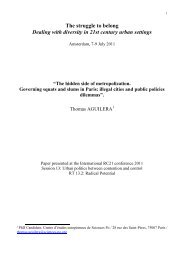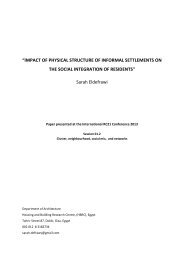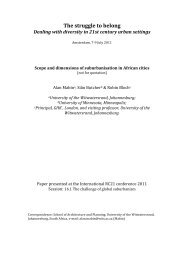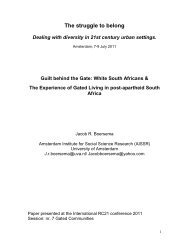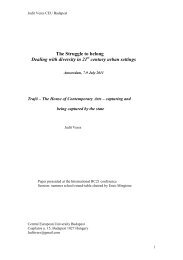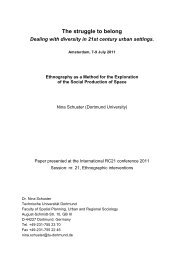Fragmentation as a threat to social cohesion - RC21 ORG ...
Fragmentation as a threat to social cohesion - RC21 ORG ...
Fragmentation as a threat to social cohesion - RC21 ORG ...
Create successful ePaper yourself
Turn your PDF publications into a flip-book with our unique Google optimized e-Paper software.
fragmented physical structure but the fragmentation of the political organization of<br />
space (Gl<strong>as</strong>ze et al. 2005) w<strong>as</strong> <strong>threat</strong>ening urban entirety.<br />
Still, the urban geographical research, specifically speaking of fragmentation,<br />
primarily focused on the phenomenon of gated communities in different cultural<br />
contexts. “The other side”, i.e. the deprived or marginalized zones of the urban<br />
undercl<strong>as</strong>s were mainly neglected in empirical research, in spite of its weight for the<br />
urban and societal entirety. Though these fragments are representing the far larger<br />
part of urban societies and cities <strong>to</strong>day, they are covered behind the denomination of<br />
an anonymous m<strong>as</strong>s, like a “Planet” (Davis 2007), labeled by its status of poverty or<br />
being subaltern.<br />
In drawing upon Brazilian cities and the perception of favel<strong>as</strong> <strong>as</strong> “disordering<br />
fragments”, we will develop a perspective that seeks <strong>to</strong> combine the analysis of<br />
fragmentation <strong>as</strong> a perceived <strong>threat</strong> with a focus on daily <strong>social</strong> practice. This, we<br />
believe, is an important t<strong>as</strong>k of research <strong>to</strong> understand fragmentation which, so far,<br />
h<strong>as</strong> been generally outlined from the viewpoint of globalizing networks and the<br />
isolation of urban elites, where favel<strong>as</strong> are being constructed <strong>as</strong> the “rest” or<br />
<strong>threat</strong>ening “other”. Focusing on the production of space in everyday practice helps,<br />
according <strong>to</strong> Edward Soja (2010, 31), “<strong>to</strong> ground the search for spatial justice in<br />
<strong>social</strong>ly produced contexts rather than letting it float in idealized abstractions and <strong>to</strong>o<br />
e<strong>as</strong>ily deflected calls for universal human rights or radical revolution.”<br />
4. Favel<strong>as</strong> and the <strong>social</strong> production of (uneven) spaces<br />
Favel<strong>as</strong> are widely known and quoted in urban research <strong>as</strong> a symbol for the sociospatial<br />
segregation of Brazil's larger cities (Valladares 2002, 213). Apparently they<br />
are the visible proof for the “divided city” (“cidade partida”, Ventura 1994),<br />
representing the informal part of the urban society and economy.<br />
Favel<strong>as</strong>, or slums <strong>as</strong> they are often misleadingly called, are mainly known <strong>as</strong> the<br />
quarters of the urban poor. They are the living quarters for at le<strong>as</strong>t a third of Brazil's<br />
urban population. People who live there form the lower cl<strong>as</strong>s, and <strong>social</strong> mobility is<br />
rather restricted, which means that those who are born in<strong>to</strong> these socio-spatial<br />
arrangements are those who form and reproduce them throughout their lives. They<br />
provide the greater city with a large workforce on a minimal per-capita income.<br />
Without them, urban life <strong>as</strong> it is now would ce<strong>as</strong>e <strong>to</strong> exist. As Beatriz Jaguaribe<br />
(2007, 100) characterizes in her considerations about the phenomenon of favel<strong>as</strong>,<br />
they<br />
…“are an overwhelming feature of city life in Brazil. The contradic<strong>to</strong>ry relations<br />
between the favela and the city constitute a key issue of the Brazilian urban<br />
experience because they translate how the expectations of the modern<br />
metropolis have been both frustrated and partially fulfilled. They have been<br />
defeated because the material promise of modernity <strong>as</strong> access <strong>to</strong> goods and<br />
services h<strong>as</strong> been undermined by the radical economic and <strong>social</strong> inequality<br />
between the rich and the poor. Yet, they have been also enacted because the<br />
modernizing urban scenario is a crucial site for the invention of new forms of<br />
<strong>social</strong> identity, democratic struggle, and individual <strong>social</strong> mobility“.<br />
On first sight, this means that favel<strong>as</strong> are economically highly interrelated with other<br />
socio-spatial units in Brazilian cities and may not be characterized <strong>as</strong> disconnected<br />
fragments of a segmented urban economy. Still, they are perceived <strong>as</strong> somehow<br />
disconnected or detached fragments. To examine this ambiguity more closely, we<br />
7 Deffner, Hoerning: <strong>Fragmentation</strong> <strong>as</strong> a Threat <strong>to</strong> Social Cohesion?


